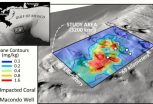(Press-News.org) PULLMAN, Wash. - Politicians who discredit global warming risk losing a big chunk of the female vote. A new study found women who consider the long-term consequences of their actions are more likely to adopt a liberal political orientation and take consumer and political steps to reduce global warming.
Jeff Joireman, associate professor of marketing at Washington State University, demonstrated that "future-oriented" women are the voting bloc most strongly motivated to invest money, time and taxes toward reducing global warming.
Previous studies have shown that women and those with liberal viewpoints are more likely to act to protect the environment than men and conservatives. Joireman's model helps explain why this occurs and is the first to document the combined influence of gender and concern for the future.
The findings were published this month online in the Journal of Environmental Psychology.
Joireman (YOUR-man) said belief in global warming is positively linked to outdoor temperatures, so in light of recent record-breaking heat, people may have climate change on their minds during next week's midterm elections, especially future-oriented women.
It just so happens that September was the hottest on record in 135 years, and the National Oceanic and Atmospheric Administration projects 2014 will likely break the record for hottest year.
This year's political contests are also heated, with environmental ads surging to record levels. More than 125,000 political spots cite energy, climate change and the environment – more than all other issues except health care and jobs - according to an analysis by Kantar Media/CMAG.
Social dilemma
Motivating the wider populace to engage and take action on global warming, however, is an ongoing challenge, said Joireman.
"Decisions that affect global warming pose a dilemma between what is good for individuals in the 'here and now' versus what is good for society and the environment 'in the distant future,'" he said.
"Unfortunately, it can take several decades for the lay public and lawmakers to realize there is a problem that needs fixing. This is clearly the case with global warming, as the consequences of our current lifestyle are not likely to be fully realized for another 25 to 50 years."
Live for today or tomorrow?
Hoping to clarify another piece of the global warming psyche, Joireman investigated how the time element contributes to people's willingness to address climate change.
For the study, he focused on the personality trait called "consideration of future consequences."
Those who score high on the trait scale tend to be very worried about the future impacts of their actions, while those with lower scores are more concerned with immediate consequences.
Joireman and his team polled 299 U.S. residents, with an age range from 18 to 75. Forty-eight percent of the respondents were female and 80 percent were Caucasian.
Women scored higher than men on liberal political orientation, environmental values, belief in global warming, and willingness to pay to reduce global warming when their concern with future consequences was high.
But, it wasn't a simple gender difference. Women scored lower than men on liberal political orientation and willingness to pay when their concern with future consequences was low.
Future-oriented women step up
Joireman said a specific chain of influences makes future-oriented women more likely to take action. First, they are more politically liberal and liberals are more likely to value the environment, which makes them more likely to believe in global warming. All together, these effects lead to a willingness to pay more in goods, services and extra taxes to help mitigate climate change.
"Future-oriented women, for example, might be more willing to pay higher prices for fuel-efficient cars, alternative forms of transportation and energy efficient appliances. They might also eat less meat, all to help lower greenhouse gas emissions," he said.
Appealing
The question for environmental advocates now, said Joireman, is to "figure out how to motivate all people to engage in behaviors that reduce global warming. To be effective, we will likely need to tailor persuasive messages to appeal to the consequences people value."
"If people are not worried about future consequences, we have to try to appeal to their more immediate concerns – like encouraging them to buy a fuel efficient vehicle so they can instantly start saving money on gas."
INFORMATION:
Both agave nectar and a placebo were more effective than no treatment for young children's cough symptoms, according to researchers at Penn State College of Medicine. The findings suggest that a placebo could help children more than "watchful waiting."
The Food and Drug Administration recommends against the use of over-the-counter cough and cold medications in children under two years old due to safety concerns and a lack of evidence for their effectiveness in this age group. As part of a voluntary change announced in 2008 by the Consumer Healthcare Products Association, ...
Astronomers with the National Science Foundation (NSF)-funded National Optical Astronomy Observatory (NOAO) captured pictures not only of Thursday's partial solar eclipse, but also of the "monster" sized active region or sun spot that has many comparing it to one of a similar size that occurred 11 years ago.
The sun spots were earlier reported by scientists with the NSF-supported National Solar Observatory. According to astronomers Frank Hill and Kiran Jain, "As of Oct 21, 2014, a very large active region is currently on the solar disk and producing flares as strong as ...
A large active region on the sun erupted with another X-class flare on Oct. 27, 2014 -- its fourth since Oct. 24. The flare peaked at 10:47 a.m. EDT.
X-class denotes the most intense flares, while the number provides more information about its strength. An X2 is twice as intense as an X1, an X3 is three times as intense, etc.
To see how this event may affect Earth, please visit NOAA's Space Weather Prediction Center at http://spaceweather.gov, the U.S. government's official source for space weather forecasts, alerts, watches and warnings.
Continuing a week's worth ...
A world without plants would be a world without oxygen, uninhabitable for us and for many creatures. We know plants release oxygen by absorbing carbon dioxide and breaking down water using sunlight through the process of photosynthesis. However, we know little about the mechanics of how plants create oxygen during photosynthesis. A breakthrough that will help advance our understanding of this critical ecological process was made recently by scientists at LSU.
"Without photosynthesis or oxygen, basically all recognizable life that we see in our landscape would be gone: ...
Chicago, October 27, 2014—The Associated Press-NORC Center for Public Affairs Research today released the results of a major new study and related reports on the recovery from Superstorm Sandy in 12 New York and New Jersey neighborhoods hard hit by the 2012 storm.
It is the second AP-NORC study that has focused on the aftermath of Superstorm Sandy, with findings that emphasize the important role social factors play in a neighborhood's resilience: the ability of people and their social systems to survive, adapt and continue moving forward after a disaster. Funding ...
This news release is available in French. One in three children who have been reunified with their families after being placed in foster care will be maltreated again, according to a study into Quebec's youth protection system by Marie-Andrée Poirier and Sonia Hélie of the University of Montreal's School of Social Services. The study, the first of its kind in the world, was undertaken in the wake of a new law intended to improve the family stability of youth receiving child protection services.
The researchers, who are also affiliated with the Centre jeunesse ...
Due to its unprecedented scope, the damage assessment caused by the 2010 Deepwater Horizon spill in the Gulf of Mexico has been a challenge. One unsolved puzzle is the location of 2 million barrels of submerged oil thought to be trapped in the deep ocean.
UC Santa Barbara's David Valentine and colleagues from the Woods Hole Oceanographic Institute (WHOI) and UC Irvine have been able to describe the path the oil followed to create a footprint on the deep ocean floor. The findings appear today in the Proceedings of the National Academy of Sciences.
For this study, the ...
Humans are the only primates with large, highly visible sclera – the white part of the eye.
The eye plays a significant role in the expressiveness of a face, and how much sclera is shown can indicate the emotions or behavioral attitudes of a person. Wide-open eyes, exposing a lot of white, indicate fear or surprise. A thinner slit of exposed eye, such as when smiling, expresses happiness or joy. Averted eyes, as well as direct eye contact, can mean several things. So the eye white, or how much of it is shown and at what angle, plays a role in the social and cooperative ...
It's an often-agonizing challenge facing any parent of a child with autism: How can I help my son or daughter socialize with his or her typically developing peers? The solution, SF State's Pamela Wolfberg found, may lie in a different type of playgroup that focuses on collaborative rather than adult-directed activities.
A new study shows that "Integrated Play Groups," or IPGs, developed by Wolfberg over several years, are effective in teaching children with autism the skills they need to interact with their peers and engage in symbolic play such as pretending. In IPGs, ...
Where's the remaining oil from the 2010 Deepwater Horizon disaster in the Gulf of Mexico?
The location of 2 million barrels of oil thought to be trapped in the deep ocean has remained a mystery. Until now.
Scientist David Valentine of the University of California, Santa Barbara (UCSB) and colleagues from the Woods Hole Oceanographic Institution (WHOI) and the University of California, Irvine, have discovered the path the oil followed to its resting place on the Gulf of Mexico sea floor.
The findings appear today in the journal Proceedings of the National Academy ...






